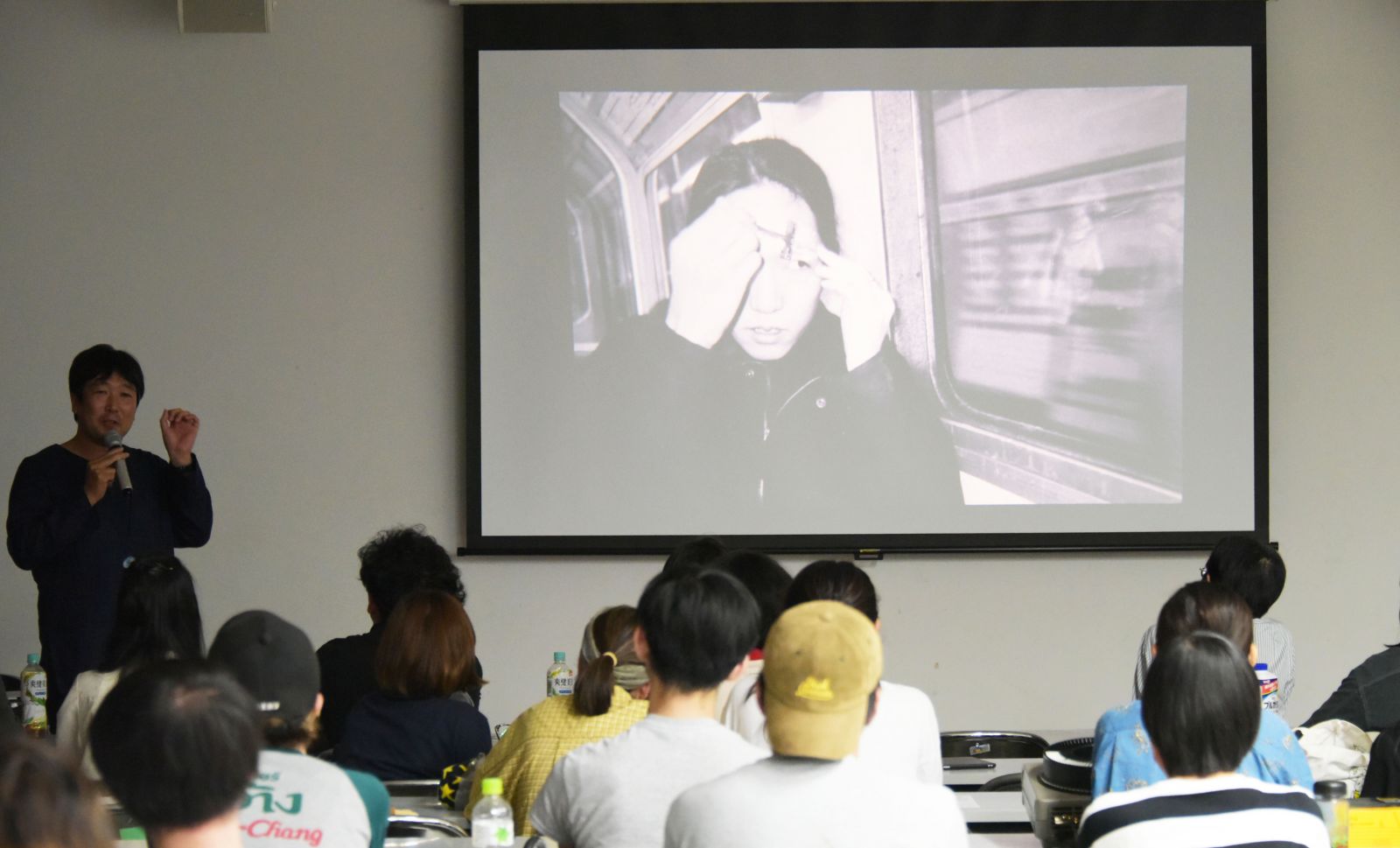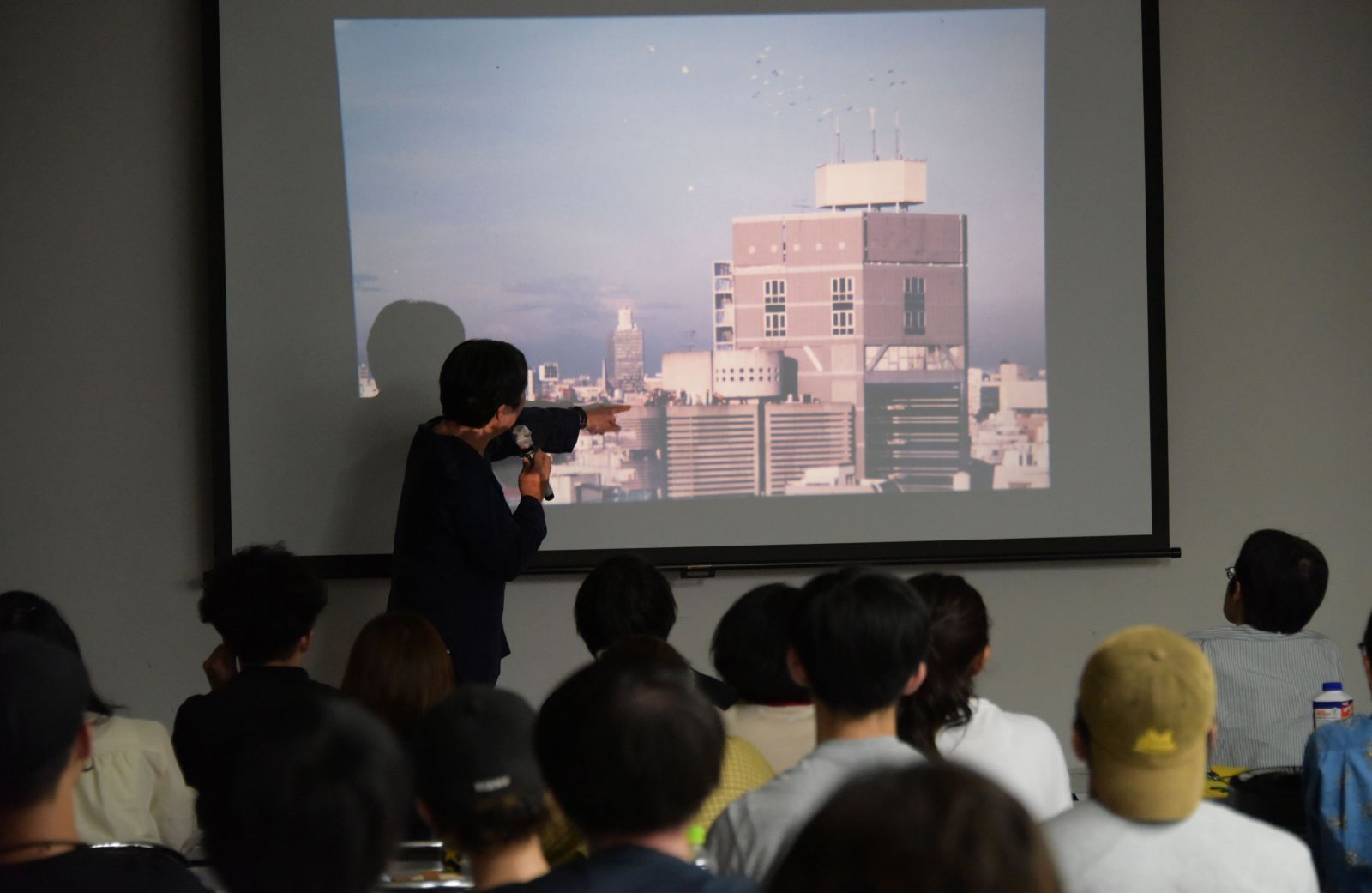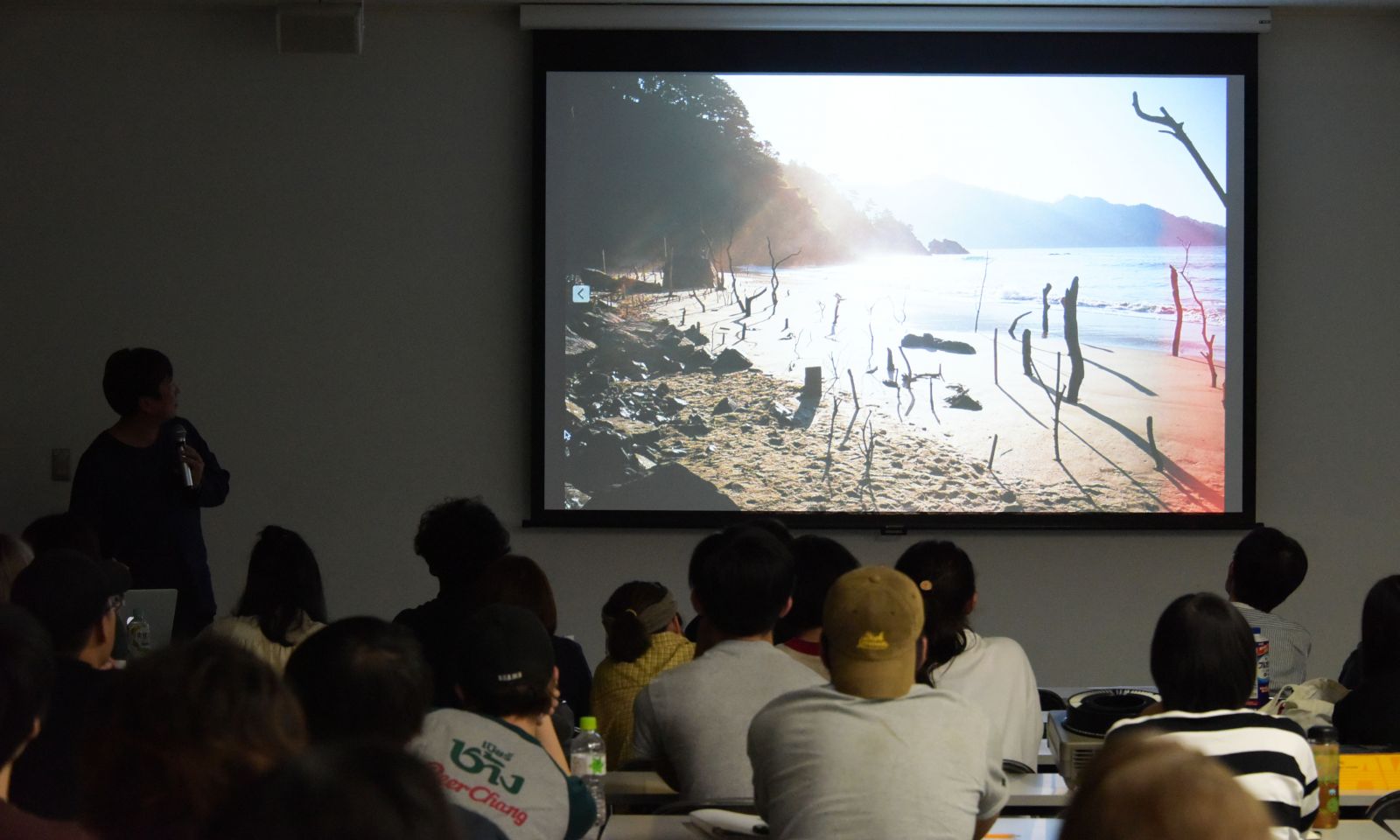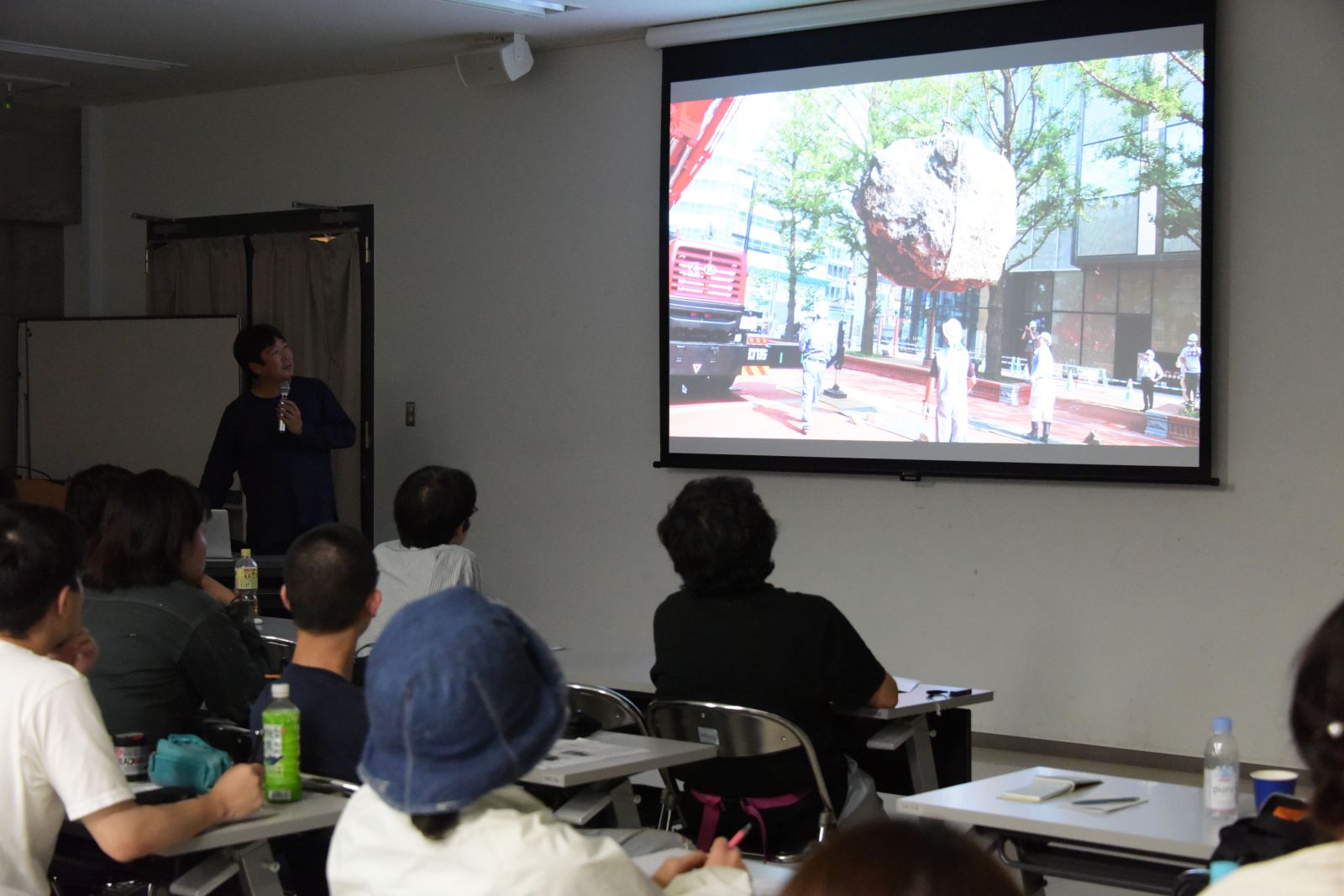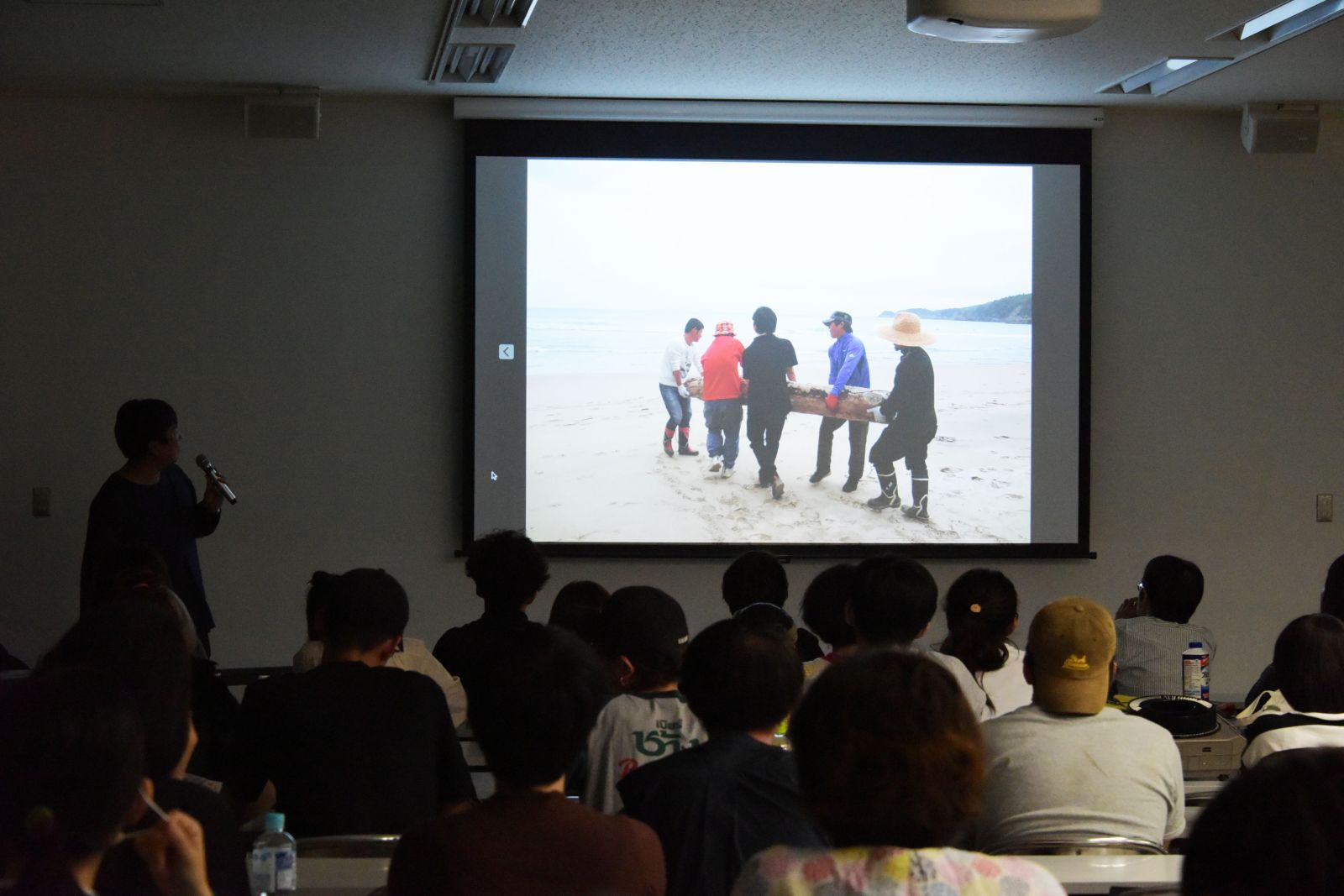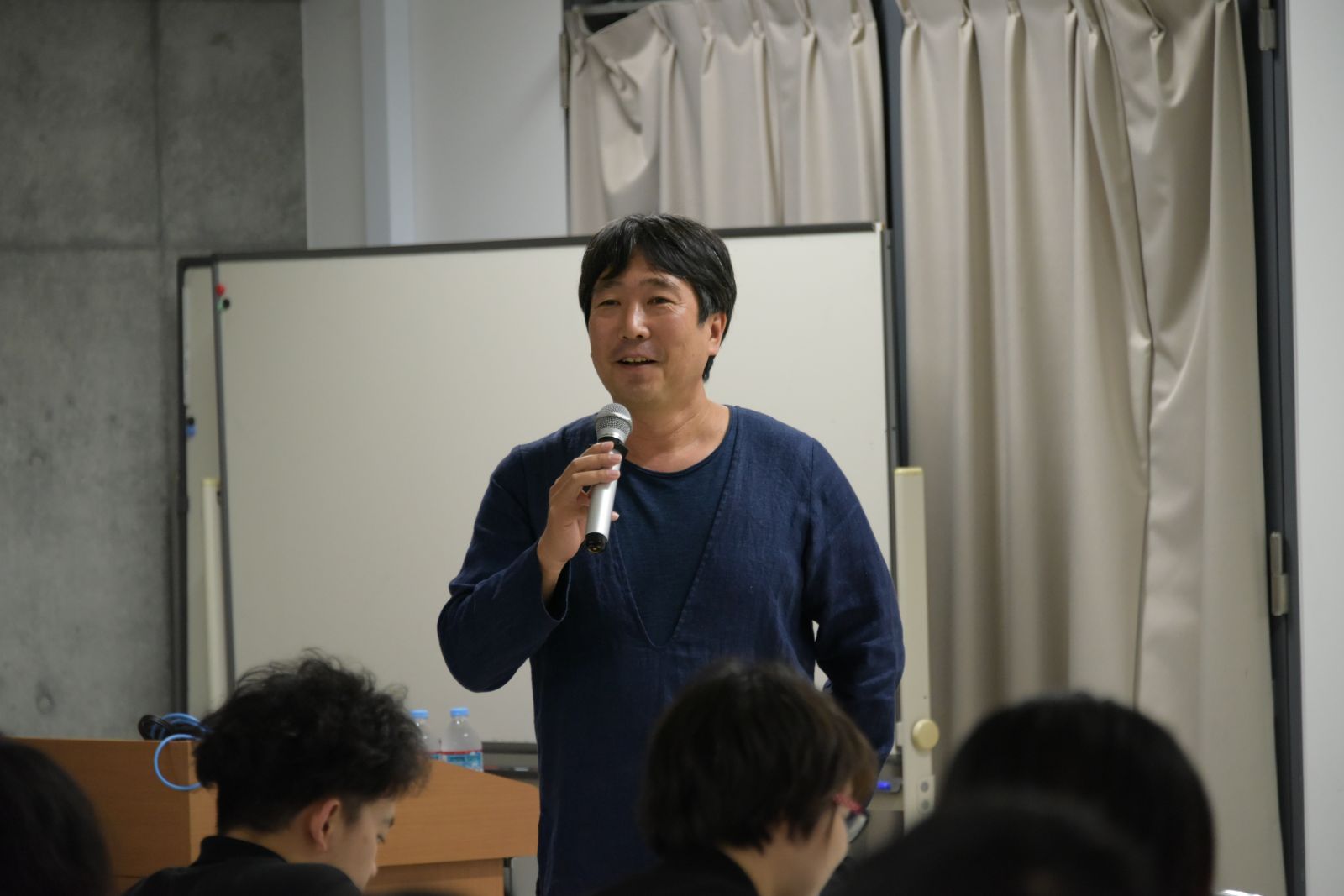
2018年6月11日(月)、京都造形芸術大学と東山 アーティスツ・プレイスメント・サービス(HAPS)共催による「グローバル・アート・トーク」では、美術家で大学院グローバル・ゼミゲスト講師の島袋道浩氏によるレクチャーを開催。本学では三回目となる島袋氏の今回の講演は、これまでと異なる形で、彼の出発点から近作について自身の半生を振り返るように語って頂きました。日本を飛び出し、いかなる考えで一人のアーティストとして自立していったのか、約30年の道のりを辿ります。(文/石黒 健一)
島袋氏はアーティストの出発点として、十代の頃まで遡り、当時窮屈に感じていた生活の中で、芸術や詩に自由を見出していたと語る。
神戸でサラリーマンの家庭に生まれ育つも、書道を嗜んでいた母親に連れられ、幼少期から芸術に触れ合う機会が多くあり、中学生の頃にはアーティストになることを意識していた。退屈な高校生活を面白くするため、校内に猫を連れてきて飼ったり、犬に眉毛を書いたりしていたと笑い話のように話していたが、既成のシステムに縛られない思考から行為が生まれてくる彼の作品の片鱗が、既にこの頃の遊びのような行為から感じられるのではないだろうか。
進路を考える中で芸大への進学も考えたが、当時の芸大受験といえばデッサンが主体であり、決まったレールに乗る事への疑いから別の道を模索していた。高校を出た後の一年間、当時から頻繁に通っていた美術館やギャラリーで出会う大人たちに話を聞いて得た情報から、アメリカの大学へ編入可能な大阪美術専門学校に辿り着く。版画科に入学した島袋氏は、講師だった日下部 一司氏に勧められ、このときから写真を撮り始める。その後、成績優秀者としてサンフランシスコ・アート・インスティテュートに編入することになり、念願の海外へと足を踏み出すことになったのだった。
編入したばかりのサンフランシスコ・アート・インスティテュートから半年後には大学のインディペンダント・スタディ・プログラムで憧れのヨーロッパへ行くことになった。ロンドンを拠点に夜行列車で移動しながら各地の美術館を巡り続けた島袋氏は、その移動の中で《片方の眉毛を剃ってヨーロッパを旅した》(1991年)という初期作品の一つを作り、その後も他者とのコミュニケーションをプロセスとする数々の作品を生み出してゆく。
貸画廊、受験、美術館の開館時間といった人々が疑いもしない既成のシステムに疑問を投げかけ、1999年のワタリウム美術館でのグループ展「エンプティーガーデン」で行ったプロジェクト《夜明けの鳥と》では、心で感じる芸術という創作不可能な現象とも思えるような行為を、ある種の魔法のように立ち上げていった。「風船が空の向こうに消えて行くとか、ただ鳥が飛んでいるだけとか、原始的な喜び、理屈じゃない朝日や夕焼けのようなことをやりたかった」と、このプロジェクトについて語る島袋氏は、東京の地下鉄の始発に合わせて「早朝5時40分に美術館に集合」というアナウンスのみで4日間のプロジェクトを行った。美術館に集まった観客は何が起こるか知らされず屋上に上がり空を眺めていると、突如白い風船が空に上って行く。その後、数百羽のハトが美術館の周りを飛び回った。日常の中のひとときの出来事とも思える現象を重ねる事で、偶然にしては出来すぎている瞬間を作り出し、「原始的な喜び」へと人々を誘った。
トークの後半は、最近のプロジェクトの話題へ。2017年の宮城県石巻で開催された「リボーン・アート・フェスティバル」には、ワタリウム美術館の和多利姉弟(館長の恵津子氏、CEOの浩一氏)のキュレーションにより参加。震災後の牡鹿半島に残された数少ない自然の浜辺に出会い、そこにあるものだけで作品を手掛けた。それは浜辺に流れ着いた大量の流木を、たくさんの人とともに立てていくという、子供の遊びのような行為をくりひろげたものだった。島袋氏はこの作品を振り返り、石でも木でも、横たわっているものを起こすという行為は「彫刻の始まりのような気がした」「ただものを立てることだけでも人間の意志を感じられる」と語る。2019年も宮城県石巻で「リボーン・アート・フェスティバル」が開催され、参加するという。島袋氏が手がけたこの地で、再び新しい出来事に出会うことができることだろう。
約30年間、各地へ移動を続け、そこで出会う土地、人々と共に出来事を作りだしてきた彼にとっての芸術とは「自分を開放してくれたり、自由への表現としての思いは揺るがない。人々にとってもそうあるべきだと思っている」と、幼少期の頃から今も変わらない一貫した思いに象徴されているのではないだろうか。
What does it mean to live as an artist?
GLOBAL ART TALK, presented by Kyoto University of Art and Design and the Higashiyama Artists Placement Service, held a lecture of an artist SHIMABUKU on Monday, June 11, 2018. He is one of guest lecturers of the Global Seminar in the Graduate School this year. It was his third talk at the school, and differing from previous times, as if reflecting back on half a lifetime, he talked about his beginnings to his recent works. Leaving Japan, what kind of thinking did he have to be independent as a solo artist? It was a journey of approximately 30 years. (Text by Kenichi Ishiguro)
SHIMABUKU spoke about his beginning as an artist in his teens, when he felt a constraint in his life and discovered freedom in art and poetry.
Although SHIMABUKU was born and raised in a family with his father as an office worker, his mother had a liking for calligraphy and often took him to lessons, so he was exposed to the arts as a child. It was in junior high school that he decided to be an artist. In order to make his boring high school life more interesting, he talked with humor about how he brought cats to the school and raised them there or drew eyebrows on dogs. Even at this stage as if playing, one can say there is a glimpse of his works that are born from a way of thinking that is free from established systems.
When thinking of post-secondary education, he thought about attending an art university, but most entrance exams at that time were centered on drawing, so he decided to pursue another path instead of conforming to a predetermined standard. After graduating from high school, he visited museums and galleries for one year and from talking to adults, he decided to attend Osaka College of Art, which allowed a transfer to an American university. Although SHIMABUKU entered the Printmaking Department, it was around this time that he started taking photographs under the suggestion of his teacher Kazushi Kusakabe. Thereafter, as a student with good academic results, he fulfilled his wish to go abroad by transferring to San Francisco Art Institute.
Just six months into his transfer to San Francisco Art Institute, he could go to Europe, a place he longed for, through the Independent Study Program. With his base in London, he took night trains to visit museums all around Europe. During these trips, he made his early work Tour of Europe with One Eyebrow Shaved (1991) as well as several other works thereafter that focused on the process of communicating with others.
Questioning established systems that we take for granted such as rental galleries, entrance exams, and times when art museums are open, he exhibited the project, With Birds at Dawn at the group exhibition Empty Garden held at Watari Museum of Contemporary Art in 1999. In this project, he carried out an act that seems to be a phenomenon impossible to create such as experiencing art in one’s heart, like some kind of magic. SHIMABUKU said, “I wanted to do something that had a primitive happiness like seeing a balloon float towards the sky or just a bird flying, something that had no theory like the sunrise and sunset.” He ran the four-day project just by making an announcement to gather at the museum at 5:40 A.M. in time with the first subway of the day in Tokyo. The people who gathered at the museum knew nothing about what would happen, but were led to the rooftop where they looked at the sky and saw balloons rising, followed by hundreds of doves flying around the museum. By layering phenomenon that is just another moment in their daily lives, he creates moments that are too perfect to be left to chance and leads people to a “primitive happiness.”
The second half of the talk focused on his recent projects. At the Reborn-Art Festival 2017 at Ishinomaki, Miyagi prefecture, SHIMABUKU participated under the curation of Ms. and Mr. Watari of Watari Museum of Contemporary Art. For his work, SHIMABUKU ended up using only materials he found at one of the few natural beaches left after the earthquake on the Oshika Peninsula. This involved people piling up the large amount of driftwood that was found on the beach, an act almost like children playing. Looking back at this work, SHIMABUKU felt that the act of picking up stones and wood was “the beginning of sculpture. Human intention is felt just by the act of stacking something.” He also plans to join the Reborn-Art Festival next year as well. No doubt, we will see something new again in this location where SHIMABUKU worked.
To SHIMABUKU, someone who has moved around the world making things with people he meets there, art “gives me a sense of release and how I think of it as a way of expression towards freedom is unwavering. I hope people feel the same way.” His work is no doubt symbolic of his unchanging way of thinking, from when he was a child to now.
京都芸術大学 Newsletter
京都芸術大学の教員が執筆するコラムと、クリエイター・研究者が選ぶ、世界を学ぶ最新トピックスを無料でお届けします。ご希望の方は、メールアドレスをご入力するだけで、来週水曜日より配信を開始します。以下よりお申し込みください。
-
京都芸術大学 広報課Office of Public Relations, Kyoto University of the Arts
所在地: 京都芸術大学 瓜生山キャンパス
連絡先: 075-791-9112
E-mail: kouhou@office.kyoto-art.ac.jp
